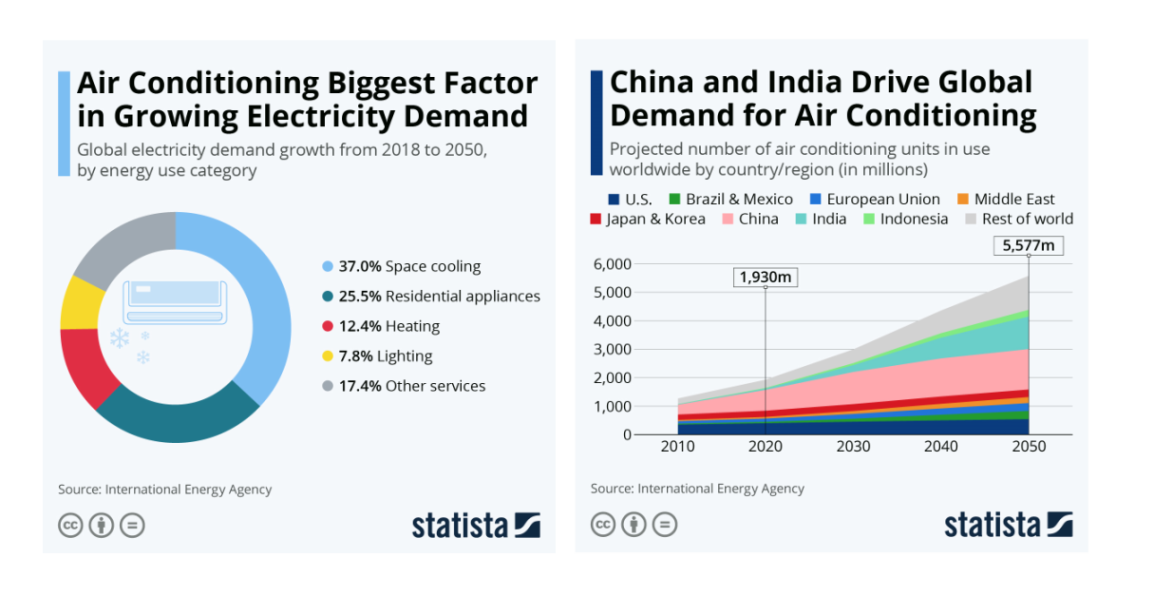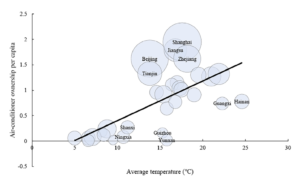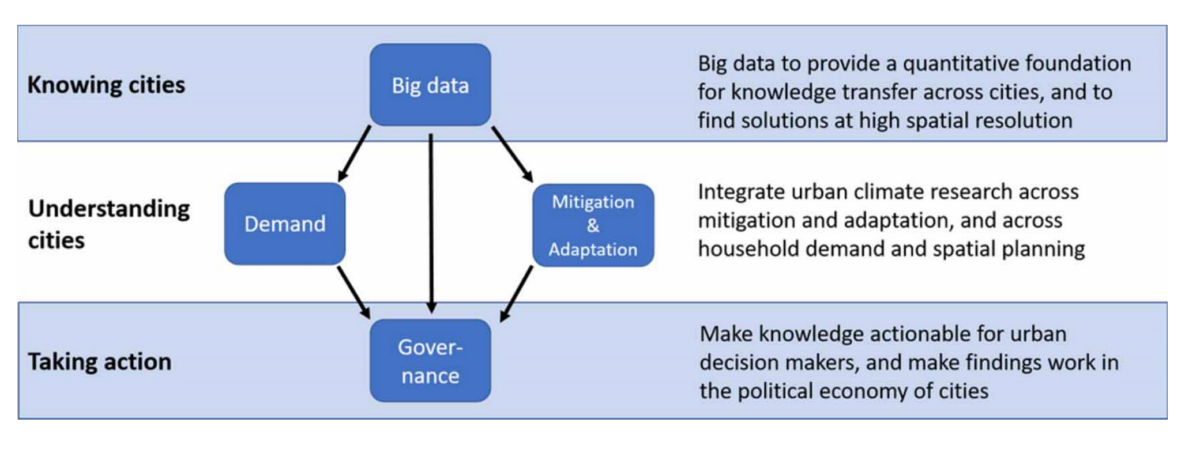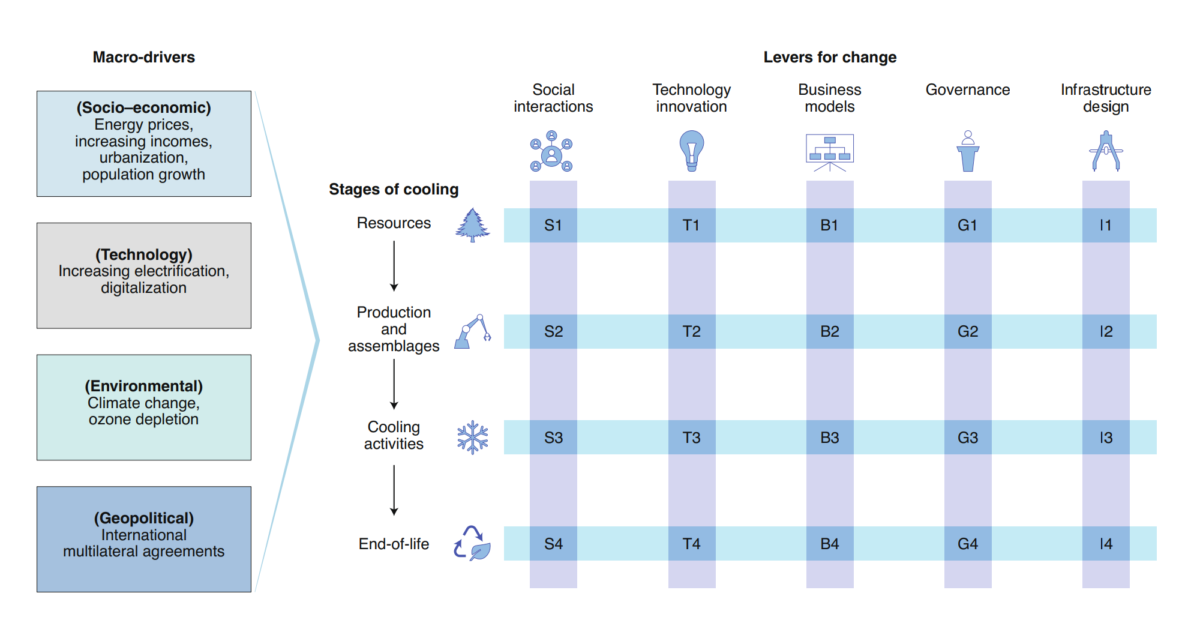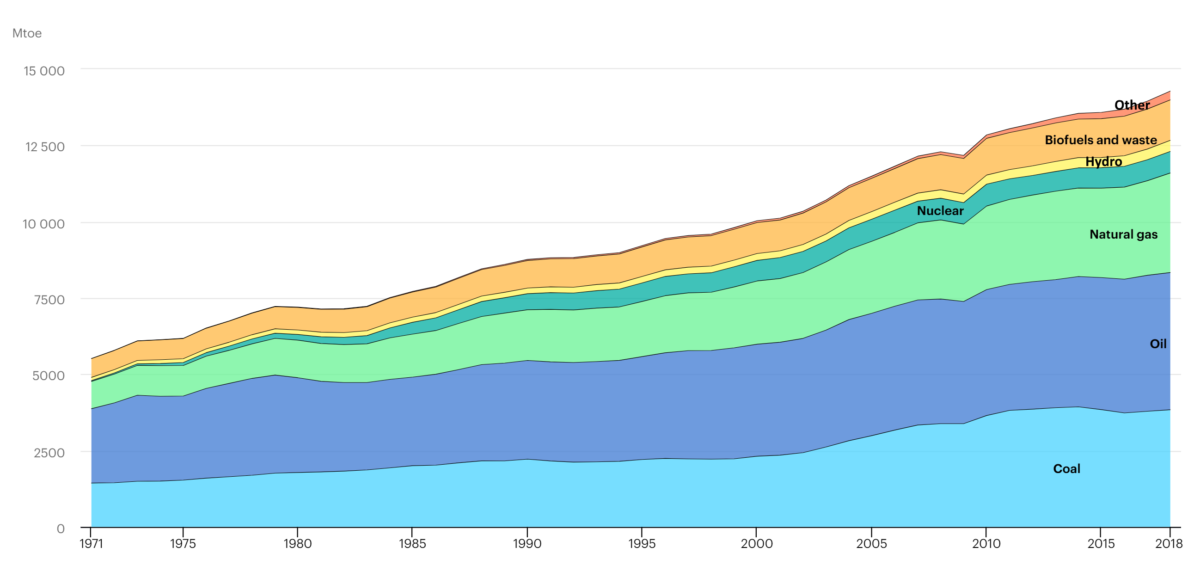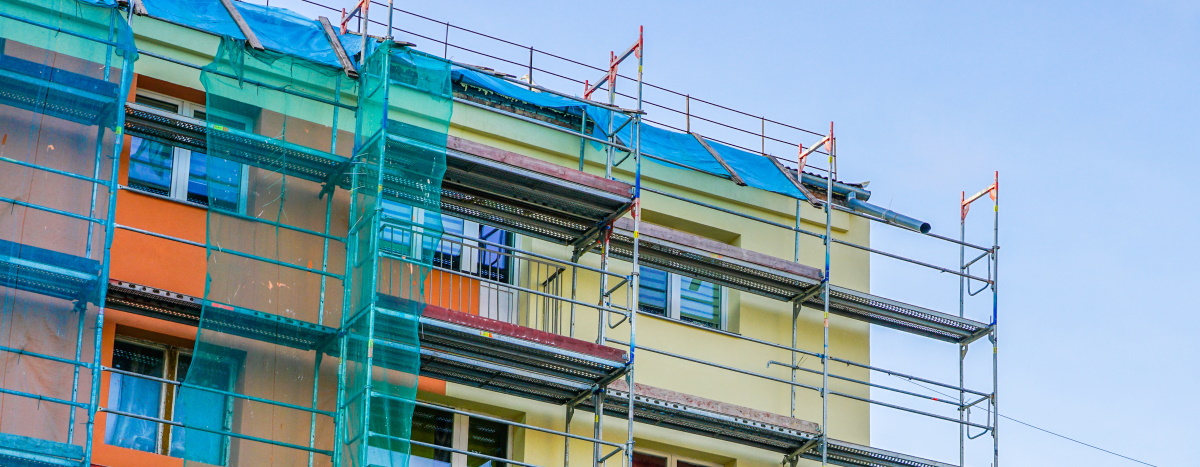Latest Cooling News: the G20, air conditioners, cities, green procurement and philanthropy
Hello and welcome to the monthly newsletter from the Oxford Martin School Programme on the Future of Cooling. The newsletter covers the latest cooling news and research updates; you can see previous editions here.
Kigali
 Since we last looked, four more countries have ratified the Kigali Amendment: Turkmenistan, Kyrgyzstan, Liechtenstein, and Botswana.
Since we last looked, four more countries have ratified the Kigali Amendment: Turkmenistan, Kyrgyzstan, Liechtenstein, and Botswana.
This means 104 countries have committed to cut the production and consumption of HFCs by more than 80% over the next 30 years. Woop!
Making cooling a priority for the G20
Radhika Khosla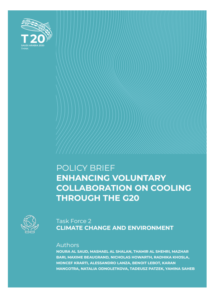 , of the Programme on the Future of Cooling contributed to a policy brief to make cooling a priority for the upcoming G20 meeting on 21-22 November in Saudi Arabia.
, of the Programme on the Future of Cooling contributed to a policy brief to make cooling a priority for the upcoming G20 meeting on 21-22 November in Saudi Arabia.
The brief, “Enhancing voluntary cooperation on cooling in the G20” is promoted by Saudi Arabia, as it currently holds the G20 Presidency and is a country where cooling is essential to life, development and wellbeing.
The brief calls for enhanced cooperation on cooling at the G20 level, in order to broaden membership, increase resourcing and commitment, and to better coordinate and learn from best practices, especially given the emerging policy needs presented by COVID-19.
The recommendations include:
- Fast implementation of the 2016 Kigali Amendment to phase down hydrofluorocarbons
- Make a strong declaration, similar to the G7’s Biarritz Pledge for Fast Action on Efficient Cooling.
- Combine knowledge on solutions, policies, and best practices for safe ventilation and filtering of air in order to prevent the indoor spread of COVID-19 and other viruses
- Support global access to vaccines though reliant and efficient medical cold chains
- Collaborate for stronger impact on cooling through initiatives such as the G20 Energy Efficiency Leading Program and Task Group on District Energy Systems.
- Phase out the most inefficient technologies and accelerate the adoption of the best available technologies
- Encourage higher adoption of cooling solutions such as smart grids, building design, urban planning, and green spaces.
- Boost funding for next-generation high-efficiency, safe, low global warming potential cooling equipment that can effectively control COVID-19 transmission, without aggravating climate change.
- Enhance trade in high energy efficiency products and design of anti-dumping policies to prohibit the import of both new and used obsolete technologies.
- Support global food security through reliable and efficient cold chains
The rise of air conditioners
In its 2020 Progress Review on Cooling, the IEA (2020) report that the global energy demand for space cooling has more than tripled since 1990, making it the fastest-growing end use in buildings.
This is not good news for emissions, as space cooling was responsible for about 1 GtCO2 and nearly 8.5% of total final electricity consumption in 2019.
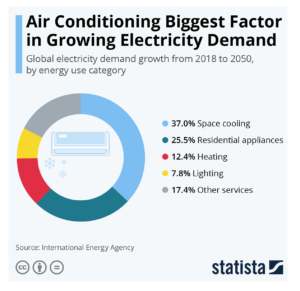 Currently about 2 billion air conditioning (AC) units are used around the world, of which 68% are residential units.
Currently about 2 billion air conditioning (AC) units are used around the world, of which 68% are residential units.
Space cooling is the leading driver of electricity demand in buildings, and AC units are mainly located in the United States, China, Japan and South Korea.
2.8 billion people live in countries where the average daily temperature exceeds 25°C.Only 10% of these people currently have air conditioners, and so it is clear that the number in use will increase. Numbers are estimated to reach 5.5 billion units by 2050, with most growth in emerging and developing economies. This is forecast to lead to a 37% growth in electricity demand over the period.
While highly efficient AC units are currently available, most consumers will likely purchase units that are much less efficient.
To put cooling on track with the Sustainable Development Goals, AC energy efficiency standards need to be improved by more than 50% by 2030. The effect of this, alongside improved building design, increased renewables integration and smart controls, could reduce future energy demand from >6,200 TWh just 3,407 TWh, as well as reduce emissions and negate the need for additional power generation capacity.
The situation in China
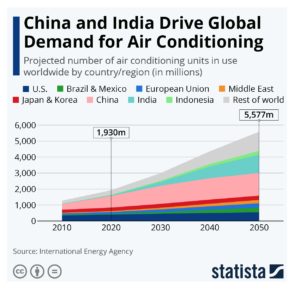 Future growth in AC installations is expected to be driven by demand in China and India. Indonesia, Mexico and Brazil are also expected to see large increases in AC use.
Future growth in AC installations is expected to be driven by demand in China and India. Indonesia, Mexico and Brazil are also expected to see large increases in AC use.
A study has been published that shows how China’s cooling-related energy consumption rocketed from 7 TWh in 1990 to 450 TWh in 2016, rising most rapidly in the last decade, from 45 TWh in 2000 to more than 450 TWh in 2016.
The researchers used Chinese residential energy consumption survey data, matched with weather data, to analyse the effect of climate change on AC usage at the household level in China.
They found that AC ownership is closely related to both income and temperature. The figure below shows AC ownership in different provinces in 2016, with the bubble size representing the net disposable income per capita.
AC ownership increases with temperature but provinces with the highest temperatures do not have the highest level of AC ownership. Rather, it is those provinces with a high level of income per capita, such as Beijing, Shanghai, etc.
The researchers also found that the number of cooling degree days significantly influence both AC energy consumption and AC usage time. When the temperature increases or persist for a longer period of time, household AC cooling energy consumption increases, increasing electricity consumption and AC usage time. In contrast average relative humidity affects only AC usage time.
The researchers call for policies to ensure high-efficiency ACs and to encourage people with existing units to replace with more efficient ones.
They mention the Chinese “Project to promote energy-efficient products for the benefit of the people”, which gave subsidies to encourage people to buy more efficient ACs. In their study however, they found that over 93% of households own ACs that are below the energy-saving standards and so initiatives are needed to address these existing poor performing units, and persuade people to replace them with very efficient ones.
Green Procurement for Cooling
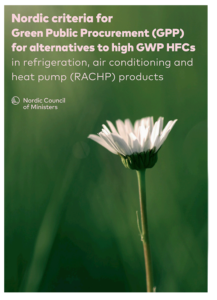 New public procurement guidelines have been released by the Nordic Council of Ministers which exclude HFC refrigerants in refrigeration and air-conditioning, where alternative low GWP or zero GWP refrigerants are approved.
New public procurement guidelines have been released by the Nordic Council of Ministers which exclude HFC refrigerants in refrigeration and air-conditioning, where alternative low GWP or zero GWP refrigerants are approved.
The Nordic Council formalises inter-parliamentary Nordic cooperation and has 87 representatives. It is using Green Public Procurement as a method to promote sustainable development and use their collective purchasing power as a tool to boost the market mechanism by directing public procurement according to environmental criteria.
It has produced green procurement criteria have been developed for 25 product groups, that can be directly inserted into tender documents issued by contracting authorities.
The objective of the new guidance is to increase the proportion of natural refrigerants in public procurement by excluding the use of HFCs and HFOs where possible. Where natural refrigerants (e.g. hydrocarbon, ammonia, CO2) are not possible, only refrigerants with a global warming potential of less 675 will be allowed. The Council has stated that natural refrigerants are applicable for most refrigeration and air conditioning products at equal cost, and can be used as a selection criteria in GPP.
Public procurement of HFC containing products covers a wide range of situations and tenders such as kitchen services, building and construction, hospitals, new white goods in public institutions, schools, and air conditioners for public buildings and IT servers.
Cities as agents of positive change
Cities are gaining attention as places that can hopefully address the goals of the Paris agreement more easily than relying on international cooperation between nation states. Radhika was also one of the authors of a study that looked to systematize and upscale urban climate change mitigation for cities.
Global-level strategies for climate change mitigation are oftentimes insufficient to inform city-scale stakeholders. There are many examples of city case studies, but these are not always scalable, or comparable to other cities.
What is needed is the ability to examine solution for climate change mitigation and adaptation that have been adopted in cities, adapt them to different locations, matching geographical and cultural contexts on the ground, and the local political economy.
There are few methods to provide insights across municipalities and potentially at global scale. To address this, Radhika and colleagues highlight four core areas for systematizing and upscaling urban climate mitigation solutions.
1: Data. Use the power of big data and associated machine learning methods, to compare types of cities and leverage collective understanding.
2: Upscale demand-side policies. Give more attention to demand-side action relating to behavioural change and modified social practices relevant to urban spaces.
3: Integrate mitigation and adaptation perspectives. Measures and solutions that coordinate mitigation with adaptation require explicit conceptualization and systematization.
4: Governance. Translate knowledge into action. All insights should come together to develop governance frameworks that translate scientific exercises into concrete, realistic and organized action plans on the ground, for all cities.
The need for Philanthropy
Cold chains can help eradicate the burden of food wastage estimated at almost $1 trillion per year.
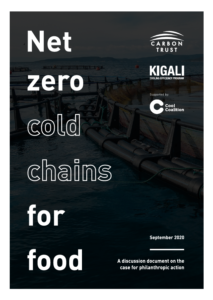
Commissioned by the Kigali Cooling Efficiency Programme (K-CEP), the Carbon Trust has produced a report focusing on the imperative to implement cold chains to reduce food waste, enhance food security and reduce poverty.
These should be net zero cold chains, to avoid the use of being locked-into energy inefficient infrastructure and minimise emissions from high GWP refrigerants.
Cold chains sit at the intersection of the world’s greatest challenges such as climate change, nutrition, health, and poverty reduction and can deliver social, economic, and environmental benefits.
Achieving a net zero cold chain requires a system transition with action across many stakeholder groups to create low carbon infrastructure, access to reliable, clean energy, and appropriate operating procedures, as well as supportive policy, regulation, and commercial incentives.
The report sets out that due to the many actors involved with differing levels of agency, an integrated approach to net zero cold chains is unlikely to emerge organically. Private sector actors may not consider developing or deploying clean technologies due to costs.
As a result, there is an opportunity for philanthropy to play a catalytic ‘systems integrator’ role, helping to reduce GHG emissions whilst delivering safer food to consumers and higher incomes to farmers.
Multi-pronged strategies and demonstrations using improved data, modelling, and awareness can show how to unlock net zero cold chains. Further, advocacy on net zero cold chains can encourage key policy, business, finance decision makers to adopt more climate friendly practices.
Please follow us on twitter to hear the latest news items on cooling, including our own work researching and shaping the unprecedented future growth in global cooling demand. @OxfordCooling

